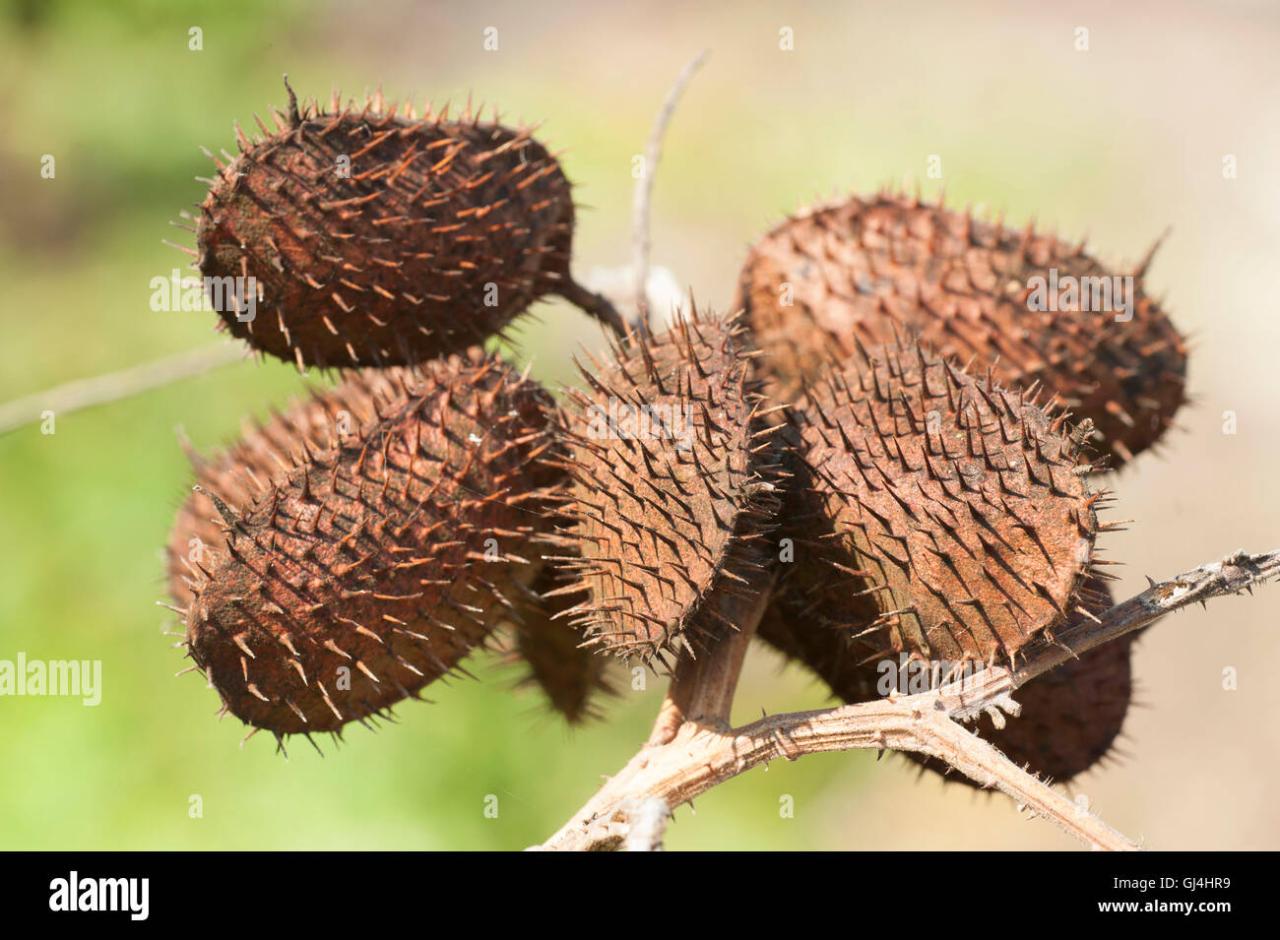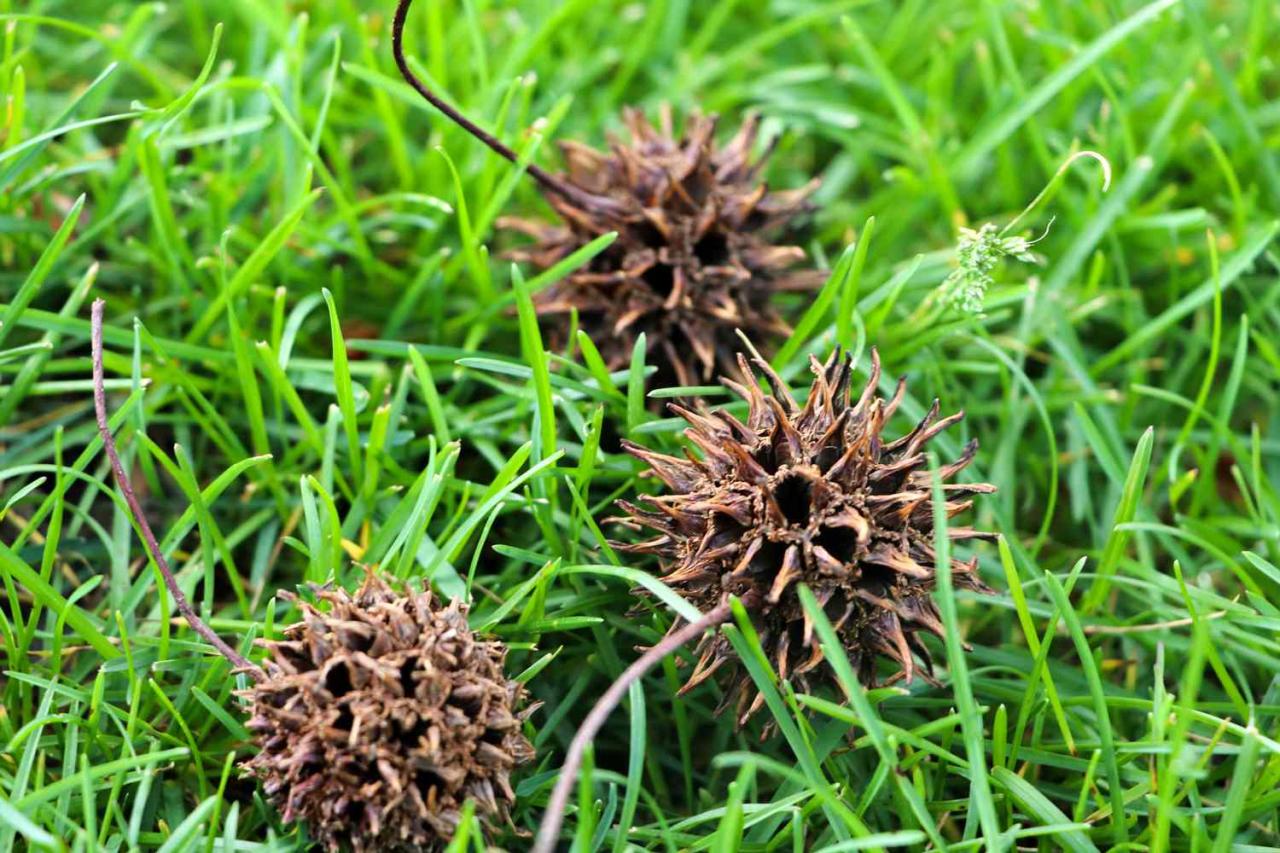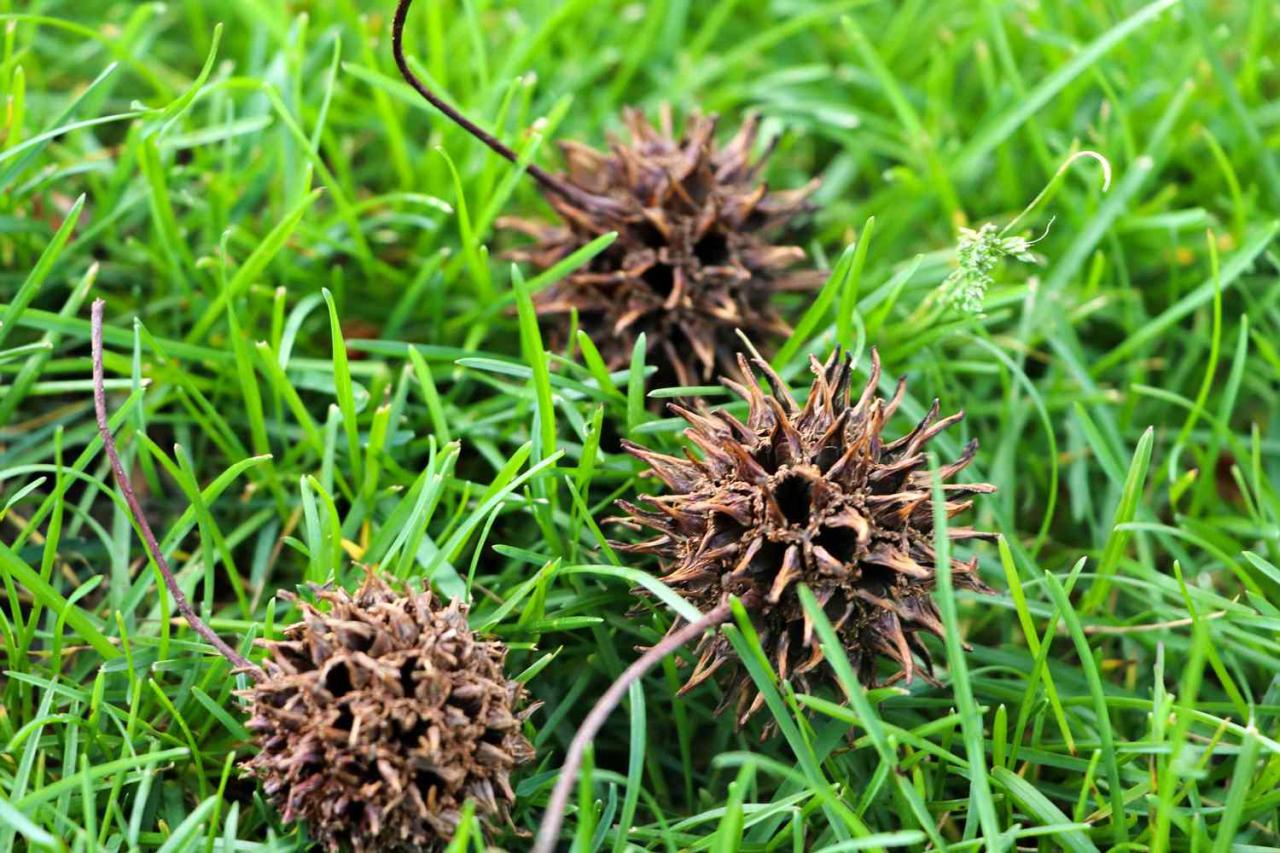How Spiky Seeds Help Plants Survive in Harsh Environments sets the stage for this enthralling narrative, offering readers a glimpse into a story that is rich in detail and brimming with originality from the outset. Imagine a world where plants face relentless challenges: scorching deserts, windswept grasslands, and dense forests.
In these unforgiving landscapes, a fascinating adaptation has emerged: spiky seeds. These seemingly simple structures play a crucial role in ensuring the survival and propagation of plant species.
Spiky seeds are not just a defense mechanism against hungry herbivores, but also a clever strategy for dispersal. Their unique shape and texture allow them to hitch a ride on the wind, water currents, or even the fur of passing animals, spreading the seeds far and wide.
This dispersal strategy is essential for plants to colonize new territories, avoid overcrowding, and increase their chances of finding suitable germination sites.
Introduction

In the realm of plant survival, spiky seeds play a crucial role in ensuring the propagation of species, especially in harsh environments. These seeds, with their unique and often formidable exterior, are a testament to the remarkable adaptability of plants in the face of challenging conditions.Harsh environments, characterized by extreme temperatures, limited water availability, and nutrient scarcity, pose significant hurdles for plant growth and reproduction.
These challenges demand that plants develop innovative strategies to thrive and perpetuate their lineage.Seed dispersal, the process by which seeds are transported away from the parent plant, is a fundamental aspect of plant reproduction. This process allows plants to colonize new territories, avoid competition with their parent plant, and escape the detrimental effects of overcrowding.
Spiky seeds, with their specialized adaptations, are often instrumental in facilitating effective seed dispersal.
Spiky Seeds and Seed Dispersal
Spiky seeds, with their prickly or barbed surfaces, have evolved to utilize various mechanisms for dispersal. Their spiky nature allows them to cling to the fur of animals, the feathers of birds, or even the clothing of humans, facilitating their transportation over long distances.
This process, known as epizoochory, plays a vital role in expanding the geographical range of plant species.
- Burrs:These spiky seeds, often found on plants like burdock and cocklebur, have hooks or barbs that readily attach to the fur of animals. As animals move about, the burrs are transported to new locations, where they can detach and germinate.
- Awned Seeds:Grasses, such as barley and wheat, produce seeds with awned structures, which are long, slender, and pointed. These awns can twist and turn in response to changes in humidity, allowing the seeds to burrow into the soil or attach to the fur of animals.
- Spiny Fruits:Plants like the prickly pear cactus produce fruits covered in spines. These spines help protect the fruits from herbivores and can also aid in dispersal. When animals try to eat the fruit, the spines may detach and become embedded in their fur, carrying the seeds to new locations.
The ability of spiky seeds to adhere to animals or objects is a crucial adaptation that enables them to travel far beyond the reach of the parent plant. This dispersal mechanism not only reduces competition for resources but also increases the chances of finding suitable environments for germination and growth.
Mechanisms of Spiky Seed Dispersal
Spiky seeds, with their unique adaptations, have evolved to utilize various mechanisms for dispersal, ensuring their survival and the propagation of their species in diverse and often harsh environments. These mechanisms are essential for reaching suitable germination sites, escaping competition with parent plants, and colonizing new areas.
Wind Dispersal
Wind dispersal is a common strategy for spiky seeds, especially those that are lightweight and possess structures that increase their surface area, allowing them to catch the wind and travel long distances.
- Parachutes and Wings:Some spiky seeds have parachute-like structures, such as those found in dandelion seeds, which allow them to float gently on the wind. Others develop wing-like appendages, similar to those found in maple seeds, enabling them to spin and glide through the air.
These adaptations help seeds travel further and reach more distant locations.
- Tumbleweeds:Certain plants, like tumbleweeds, produce spiky seeds enclosed within a dry, spherical fruit that breaks off from the plant and is rolled by the wind. As the tumbleweed rolls, the seeds are scattered along the way, ensuring wide dispersal.
Water Dispersal
Spiky seeds adapted for water dispersal often possess buoyant structures or waterproof coatings that allow them to float on water currents and reach new shores.
- Coconuts:Coconuts are a prime example of a spiky seed that relies on water dispersal. Their hard, fibrous outer shell provides buoyancy, allowing them to travel across vast distances in oceans and rivers.
- Mangrove Seeds:Mangrove trees, which thrive in coastal environments, produce spiky seeds that are viviparous, meaning they germinate while still attached to the parent plant. Once mature, these seeds drop into the water and can float for extended periods, seeking suitable locations to establish themselves.
Animal Dispersal
Spiky seeds can also rely on animals for dispersal, utilizing various strategies to hitch a ride and reach new destinations.
- Burrs:Burrs, such as those found on cocklebur plants, have spiky hooks that readily attach to animal fur or clothing. As animals move around, the burrs are carried along, detaching and releasing seeds in new locations.
- Fruit Consumption:Animals, like birds and mammals, may consume fruits containing spiky seeds. The seeds pass through the digestive tract and are deposited in feces, often far from the parent plant.
- Seed Caching:Some animals, such as squirrels and rodents, collect and bury seeds for later consumption. However, they often forget where they buried some seeds, allowing them to germinate and establish new plants.
Table of Spiky Seed Types and Dispersal Mechanisms
Spiky Seed Type |
Dispersal Method |
Environment |
|---|---|---|
Dandelion Seed |
Wind |
Open Fields, Meadows |
Maple Seed |
Wind |
Forests, Woodlands |
Tumbleweed |
Wind |
Arid, Open Environments |
Coconut |
Water |
Coastal Regions, Tropical Islands |
Mangrove Seed |
Water |
Coastal Wetlands, Estuaries |
Cocklebur |
Animal (Burrs) |
Fields, Roadsides |
Mistletoe Seed |
Animal (Fruit Consumption) |
Forests, Woodlands |
Oak Acorn |
Animal (Seed Caching) |
Forests, Woodlands |
Advantages of Spiky Seeds in Harsh Environments
Spiky seeds, also known as burrs, have evolved unique adaptations that provide them with a significant advantage in harsh environments. These adaptations enable them to survive, disperse, and establish new populations in challenging conditions where other plants may struggle. The spiky nature of these seeds provides a range of benefits, allowing them to overcome obstacles and thrive in diverse environments.
Avoiding Predation and Competition
Spiky seeds offer a defense mechanism against herbivores and other predators. Their sharp, pointed structures make them difficult to consume or digest, deterring animals from eating them. This defense mechanism helps protect the seeds from being destroyed, increasing the likelihood of successful germination.
In addition to deterring herbivores, spiky seeds also help reduce competition with other plants for resources. The spines can prevent the seeds from becoming entangled with other vegetation, allowing them to establish themselves in new areas without being overshadowed by existing plants.
Enhanced Seed Dispersal Distance
Spiky seeds are often dispersed by hitchhiking on animals. The spines easily attach to fur, feathers, or clothing, allowing the seeds to travel long distances before being released. This mechanism of dispersal, known as epizoochory, significantly increases the distance that seeds can travel from the parent plant.
The ability to reach new areas with less competition and more diverse environments contributes to the successful establishment of new plant populations.
Reaching Suitable Germination Sites, How Spiky Seeds Help Plants Survive in Harsh Environments
The spiky nature of the seeds also aids in their ability to reach suitable germination sites. The spines can help the seeds penetrate the soil, allowing them to bury themselves deeper and access moisture and nutrients. This is particularly important in arid or semi-arid environments where the soil surface can be dry and inhospitable.
The spines can also help the seeds lodge themselves in crevices or cracks in rocks, providing a protected environment for germination.
Survival and Success of Plant Populations
The combination of these advantages allows spiky seeds to contribute significantly to the survival and success of plant populations in harsh environments. Their defense mechanisms against predation and competition, coupled with their ability to disperse long distances and reach suitable germination sites, ensure that these plants can thrive in challenging conditions.
This resilience and adaptability make spiky seeds an essential component of biodiversity in harsh environments, playing a vital role in the ecosystem’s stability and resilience.
Examples of Plants with Spiky Seeds
The ability of plants to disperse their seeds effectively is crucial for their survival and propagation. Spiky seeds, with their unique adaptations, play a significant role in this process, particularly in harsh environments. Here, we explore various plant species with spiky seeds and delve into their remarkable adaptations.
Just as spiky seeds help plants survive in harsh environments by attaching to passing animals for dispersal, African violets can thrive through propagation. These delicate beauties can be easily multiplied using leaf cuttings, a process explained in detail in The Best African Violet Propagation Tips You Need to Know.
This method, similar to seed dispersal, allows for the creation of new plants from a single parent, ensuring the survival and spread of these beloved houseplants.
Plants with Spiky Seeds in Deserts
Spiky seeds are prevalent in desert environments, where harsh conditions, such as extreme temperatures, limited water availability, and strong winds, pose significant challenges for seed dispersal. Plants in these arid regions have evolved various strategies to overcome these obstacles.
- Sandbur (Cenchrusspp.) : The sandbur is a common desert grass with spiky seeds that attach to animal fur, effectively dispersing them over long distances. The spiky seeds are covered in barbs, which securely latch onto animal fur, ensuring their dispersal to new locations.
[Illustration: Sandbur seed with barbs, showing its attachment to animal fur.]
- Tribulus terrestris(Puncture Vine) : This low-growing plant produces spiky seeds with sharp, pointed structures. The spiky seeds can easily penetrate animal paws or hooves, allowing for dispersal through animal movement. [Illustration: Tribulus terrestrisseed with sharp, pointed structures.]
Plants with Spiky Seeds in Grasslands
Grasslands are characterized by open areas dominated by grasses and other herbaceous plants. The presence of grazing animals plays a crucial role in seed dispersal in these ecosystems.
- Cocklebur (Xanthium strumarium) : This annual plant produces spiky seeds enclosed within a burr-like structure. The burrs readily attach to animal fur, facilitating seed dispersal through animal movement. [Illustration: Cocklebur seed with a burr-like structure, showing its attachment to animal fur.]
- Galium aparine(Cleavers) : Cleavers is a herbaceous plant that produces spiky seeds covered in tiny hooks. These hooks effectively latch onto animal fur or clothing, aiding in seed dispersal. [Illustration: Galium aparineseed with tiny hooks.]
Plants with Spiky Seeds in Forests
Forests provide a diverse range of habitats for various plant species, including those with spiky seeds. The spiky seeds of these plants can be dispersed through a combination of mechanisms, including wind, animals, and gravity.
- Arctium lappa(Burdock) : Burdock is a common plant found in forests and other habitats. It produces spiky seeds enclosed within a burr-like structure, similar to cocklebur. The burrs effectively attach to animal fur or clothing, facilitating seed dispersal. [Illustration: Burdock seed with a burr-like structure, showing its attachment to animal fur.]
- Acerspp. (Maple Trees) : Maple trees produce winged seeds known as samaras. While not technically spiky, the samaras have a distinct wing-like structure that aids in wind dispersal. [Illustration: Maple tree seed with a wing-like structure.]
The Role of Spiky Seeds in Ecosystem Dynamics: How Spiky Seeds Help Plants Survive In Harsh Environments

Spiky seeds play a crucial role in maintaining biodiversity and ecosystem stability by influencing plant dispersal, community establishment, and interactions between plants and animals. Their unique adaptations contribute to the intricate web of life within various ecosystems.
The Contribution of Spiky Seeds to Biodiversity and Ecosystem Stability
Spiky seeds contribute to biodiversity by facilitating the spread of plant species to new areas, increasing genetic diversity, and promoting the establishment of diverse plant communities. This dispersal process helps to prevent the dominance of a single species and fosters a balanced ecosystem.
- Spiky seeds can attach to animals, facilitating long-distance dispersal and establishing new populations in remote areas. This process, known as zoochory, allows plants to colonize new habitats and expand their range, enhancing biodiversity.
- The dispersal of seeds by animals, such as birds and mammals, can lead to the establishment of diverse plant communities, as different species may have different dispersal mechanisms and preferences for specific habitats. This diversity contributes to the overall stability and resilience of the ecosystem.
- The presence of spiky seeds can also influence the structure and composition of plant communities by creating gaps in vegetation, allowing for the establishment of new species and promoting the growth of seedlings.
The Influence of Spiky Seeds on the Spread and Establishment of Plant Communities
Spiky seeds, through their dispersal mechanisms, significantly influence the spread and establishment of plant communities. Their ability to attach to animals, wind, or water allows them to reach new areas and establish new populations, contributing to the spatial distribution of plant species.
- The dispersal of spiky seeds by animals can lead to the establishment of new populations in areas where the species was previously absent, expanding the range of the species and contributing to the spread of plant communities.
- The ability of spiky seeds to attach to animals, such as birds and mammals, can facilitate the establishment of new populations in areas that are difficult for seeds to reach by other means, such as dense vegetation or water bodies.
- The dispersal of spiky seeds by wind can also contribute to the spread of plant communities, particularly in open areas where wind currents can carry seeds long distances.
The Impact of Spiky Seeds on Plant-Animal Interactions
Spiky seeds play a significant role in the interactions between plants and animals. Their unique adaptations, such as their spiky exterior, have evolved to facilitate dispersal and ensure the survival of the plant species.
- Spiky seeds can act as a form of defense against herbivores, deterring them from consuming the seeds. This defense mechanism protects the seeds from being eaten and allows them to germinate and establish new plants.
- The spiky exterior of seeds can also aid in their dispersal by attaching to animal fur or feathers, allowing for long-distance transportation. This mechanism, known as epizoochory, can facilitate the spread of plants to new areas and promote genetic diversity.
Just as spiky seeds cling to animal fur for dispersal, ensuring the continuation of plant life in challenging environments, Biota Herb: Nature’s Cure for a Healthier You provides natural remedies for a healthier you. This herb, known for its potent medicinal properties, has been used for centuries to address various ailments.
Similar to the tenacity of spiky seeds, Biota Herb demonstrates the power of nature to provide solutions for a better life.
- The interaction between plants and animals through spiky seeds can also contribute to the evolution of both species. For example, the evolution of spiky seeds in plants may have led to the evolution of specific adaptations in animals, such as specialized fur or feathers, to facilitate seed dispersal.
The Interconnectedness of Spiky Seeds with Various Ecosystem Components
Spiky seeds are interconnected with various ecosystem components, influencing and being influenced by factors such as climate, soil, and other plant and animal species.
Ecosystem Component |
Impact of Spiky Seeds |
Interconnectedness |
|---|---|---|
Climate |
Spiky seeds can adapt to different climatic conditions, allowing for the dispersal and establishment of plant communities in various environments. |
Climate influences the distribution and abundance of animals that disperse spiky seeds, affecting the spread of plant communities. |
Soil |
Spiky seeds can contribute to soil health by facilitating the dispersal of plant species and increasing soil organic matter. |
Soil type and nutrient availability can influence the germination and establishment of plants with spiky seeds. |
Other Plant Species |
Spiky seeds can compete with other plant species for resources, such as light, water, and nutrients. |
The presence of other plant species can influence the dispersal and establishment of plants with spiky seeds. |
Animals |
Spiky seeds rely on animals for dispersal, and their adaptations have evolved to facilitate this interaction. |
Animals play a crucial role in the dispersal of spiky seeds, influencing the spread and establishment of plant communities. |
Final Review
The story of spiky seeds is a testament to the incredible ingenuity of nature. These seemingly simple structures are a marvel of adaptation, enabling plants to thrive in the most challenging environments. Their ability to disperse effectively, resist predation, and find suitable germination sites contributes to the diversity and resilience of plant communities.
As we delve deeper into the world of spiky seeds, we gain a profound appreciation for the interconnectedness of life and the remarkable strategies that plants employ to survive and flourish.
Detailed FAQs
What are some examples of plants with spiky seeds?
Examples include burdock (Arctium lappa), cocklebur (Xanthium strumarium), and sandbur (Cenchrus longispinus). These plants have evolved spiky seeds that readily attach to animal fur, facilitating long-distance dispersal.
How do spiky seeds help plants avoid predation?
Spiky seeds can deter herbivores from consuming them due to their unpleasant texture. This can help protect the seeds from being eaten and destroyed, ensuring their survival and the continuation of the plant species.
What is the role of spiky seeds in maintaining ecosystem stability?
Spiky seeds contribute to ecosystem stability by ensuring the spread and establishment of diverse plant communities. This diversity is essential for maintaining healthy ecosystems and providing food and habitat for various organisms.
